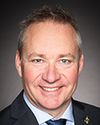Weyt-kp. Good morning. Hello to everyone here today.
My name is Phyllis Webstad. I'm from the Canoe Creek and Dog Creek, Stswecem'c Xgat'tem First Nation. I am coming to you today from Secwepemculecw, the land of the Shuswap people, in Williams Lake, B.C. Canoe Creek and Dog Creek are approximately an hour and a half southwest of Williams Lake.
Kukstemc. I thank you for the invitation to speak to Bill C-5, about a national day for truth and reconciliation. I am a third-generation Indian residential school survivor who attended the St. Joseph Indian residential school, also known as “the Mission”, near Williams Lake. My grandmother attended for 10 years, along with her 10 children, including my mother for 10 years, and I attended for one year. My son was at the last operating residential school in Saskatchewan when it closed in 1996.
I lived with my grandmother on the Dog Creek reserve until I was 10, and then went to live with my aunt when she finished university. When I turned six in July 1973, Granny took me to town to buy something to wear for my first day of school at the Mission. I chose a shiny new orange shirt. It was bright and exciting, just like I felt to be going to school for the first time. When I got to school, my shirt was taken away and I never wore it again.
It is my story of losing my shiny orange shirt purchased by my grandmother that has spread across Canada and beyond.
Orange Shirt Day was born out of the Truth and Reconciliation Commission event held in Williams Lake, B.C., in May 2013, and as a result of Chief Commissioner Justice Sinclair challenging Canadians to keep the conversation happening after the TRC wrapped up. Our theme was “Remembering, recovering and reconciling”. Our first nations, local government, schools and the RCMP all came together to hear the truth from residential school survivors. I was part of the planning for our TRC event, where I told my story of my orange shirt for the first time. We chose September because that was the time of year the children were taken away. We chose the 30th because it gives teachers and students time to settle in, to teach and learn, and time to plan an event.
At the TRC event in Vancouver, B.C., in mid-September 2013, before the first Orange Shirt Day, I overheard an elder say that September was crying month. I knew then that we had chosen the right day. September 30, Orange Shirt Day, is bringing awareness of the history of Indian residential schools and the impacts on the generations. It is a day to honour residential school survivors and their families and remember those who never made it.
What is forgotten is often repeated. Orange Shirt Day gives Canadians an opportunity to learn about, and to teach, the true history. This day acknowledges that what happened to us as children was horribly wrong, and that it will never happen again. Our slogan, “Every child matters,” began when I first told my story of my experience at residential school and how I felt that no one cared and that I didn't matter.
Residential school survivors were children when they attended those schools. They all mattered, 150,000 of them. Every child matters in the past, the present and the future.
I have two books published telling of my orange shirt story, and I'm working on the third. The first is The Orange Shirt Story, available in English, French and Shuswap, for grade kindergarten and up. There is also curriculum and the poster available.
The second is Phyllis's Orange Shirt. A lot of the illustrations are the same. The nuns and the crying were taken out. The book tells the same story, but rhymes, and is for ages four to six. It is available in English and French.
I am working on a third book, called Beyond the Orange Shirt Story, for grade 5 and up, which will tell more of my and my family's truth.
The Orange Shirt Society was incorporated in July 2015 and opened an office in Williams Lake in April 2019, at which time I became its first staff member as executive director.
The three purposes of the Orange Shirt Society are these: one, to support Indian residential school reconciliation; two, to create awareness of the individual, family and community intergenerational impacts of Indian residential schools through Orange Shirt Society activities; and three, to create awareness of the concept of “Every child matters”.
Our web page is www.orangeshirtday.org. On our web page, we post educational resources from across Canada and we are continually adding as we become aware of resources being developed.
I notice that much of the discussion in the House of Commons was around the need to educate Canadians about the history of residential schools in Canada. I believe that a national statutory holiday, a national day for truth and reconciliation, can help accomplish this. I recommend that the federal government develop curriculum for teachers to use in preparing students for the statutory holiday and in learning the history behind it.
The Orange Shirt Society published a book this past summer called Orange Shirt Day. This is a textbook for grade 5 and up, as well as for adults. I suggest that this book be distributed to schools and into the hands of children across the country. It is obvious from the amount of racism still in this country that this education and the holiday are needed.
To finish, September 30, 2021, will be the eighth year of Orange Shirt Day and, I hope, the first day of a national day for truth and reconciliation. When I see people wearing an orange shirt or a pin, it's like a little bit of justice for us survivors in our lifetime. One day there will be no survivors in Canada.
Honourable members, kukstemc. I thank you for your time today.




